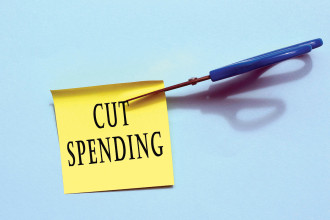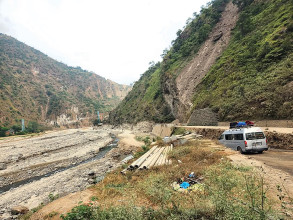
The uncertainties in the country following the Covid 19 pandemic and economic slowdown have led to rampant outmigration. Data reveals that around 2.5 million people have migrated for foreign employment and higher studies in the last three years.
“The reason behind this exodus is the lack of opportunities and also the uncertainties in the country. Most of the youth aspire to leave the country at the earliest possible,” says Gagan Thapa, member of parliament, adding, “I have never seen so much of pessimism in the society before.”
About six years back, the government had announced that it would come up with policies that would put an end to the compulsion of people having to migrate to seek foreign job opportunities within five years. With the focus on work and employment, the fiscal budget of 2018/19 vowed to create 500,000 new jobs within a year through the implementation of various programmes. One among them was the introduction of the Prime Minister Employment Programme which had been allocated a significant amount of fund. The programme has continued in the subsequent years, however it has failed to create the desired impact due to the failure to execute it effectively.
The Prime Minister Employment Programme was initiated to create more employment opportunities within the country in order to gradually develop a scenario whereby Nepalis would not have to seek foreign employment. The programme had envisaged to create employment opportunities ranging from commercial agriculture to irrigation, drinking water, river training (control), forest, tourism, transport infrastructure and other public construction sectors in all three tiers of the government.
The fiscal budget 2018/19 was significant as it prioritised work, employment and entrepreneurship. Despite this focus, the government, with its two-thirds majority at the time, could not make a substantial intervention.
A favourable environment for private sector development and encouragement of entrepreneurship have been announced several times before. However, the prevalent political instability has stifled opportunities in the country. The single-party majority government led by former Communist Party of Nepal (Unified Marxist–Leninist) Chair, KP Sharma Oli, took initiatives to create opportunities in the country. History repeats itself, as Oli has been reappointed prime minister with the mandate to address the growing pessimism in society and create hope and opportunities.
It may be too early to form an opinion on the new government, but it faces a herculean task in creating employment opportunities amid the ongoing economic crisis.
A paradox
The government, on one hand, has been expressing commitments to create job opportunities within the country, however, contradictorily, it has been looking for new avenues for Nepali foreign job seekers. The Ministry of Labour, Employment and Social Security (MoLESS) has signed agreements with a few European nations for foreign employment opportunities. In October last year, Nepal signed a labour pact with Romania and Germany. These are the first formal labour agreements with European nations. The government is preparing to sign labour pact with Portugal, Malta, Poland, Spain and Croatia, among others. The government has said that it is an attempt to diversify the labour destinations.

|
Country |
Nepali Migrant Workers |
|
Malaysia |
999,682 |
|
Qatar |
941,897 |
|
Saudi Arabia |
779,898 |
|
United Arab Emirates |
575,204 |
|
Kuwait |
149,624 |
|
Oman |
46,858 |
|
Cyprus |
12,296 |
 (Source: Department of Foreign Employment)
(Source: Department of Foreign Employment)
Ghanshyam Upadhyay, Secretary at the Ministry of Labour, Employment and Social Security, has said that the government is exploring new destinations that are more secure, have decent working environment and where human and labour rights prevail. “Our ultimate target is to create job opportunities within the country, but until that time it is duty of the government to explore better destinations for aspiring foreign job seekers,” he says.
Upadhyay further adds that the government has been emphasising on sending skilled and high-yield labour force to Europe and other countries of Asia such as South Korea, Japan and other potential destinations. Since the introduction of EPS (Employment Permit System) in Nepal in 2007, more than 100,000 Nepali workers have got the opportunity to work in South Korea. Last year alone, 20,000 people had the opportunity to work in South Korea. Likewise, nearly 2,529 Nepalis are working under specialised skilled work visa in Japan. Also, even without any formal agreement, the number of migrant workers going to Europe has increased significantly in recent years. Secretary Upadhyay says that labour agreements with European nations will not only open new avenues but also streamline the labour rights of those already working in these countries.
|
Country |
Nepali Migrant Workers |
|
Poland |
8,249 |
|
Romania |
24,636 |
|
Turkey (country in Asia & Europe) |
4,309 |
|
Malta |
10,352 |
|
Portugal |
1,952 |
|
Germany |
248 |
Dismal effort
Despite MoLESS’s focus on skilling potential foreign workers, overall efforts to develop a skilled workforce remain inadequate. Nepal faces a shortage of even semi-skilled workers like plumbers, electricians and hairdressers. This gap is filled by Indian migrant workers. The Vocational and Skill Development Training Academy, under MoLESS, struggles to meet the job market’s demand for skilled labour. “Effective monitoring and supervision are crucial for success,” says Rajendra Bhandari of the Nepal Association of Foreign Employment Agencies (NEFFA).
|
Fiscal Year |
Remittances (Rs in bn) |
|
2013/14 |
543.29 |
|
2014/15 |
617.28 |
|
2015/16 |
665.06 |
|
2016/17 |
695.45 |
|
2017/18 |
755.06 |
|
2018/19 |
879.27 |
|
2019/20 |
875.03 |
|
2020/21 |
961.05 |
|
2021/22 |
1007.31 |
|
2022/23 |
1220.56 |
|
2023/24* |
1327.51 |
(Source: Nepal Rastra Bank/*11 months of 2023/24)
Remittance: Boon for Nepali economy
Remittances are seen as a boon for Nepal’s economy, consistently greasing the wheels by fuelling imports and providing macroeconomic stability. This has bolstered the economy’s resilience against internal and external shocks. Barring major turmoil in labour destinations, remittance flows are likely to keep rising. It has improved the quality of life for recipient households and spurred economic activity. Returning migrant workers, equipped with skills and capital, are increasingly embracing entrepreneurship. “Nepal may prioritise foreign employment for years to come as there is no reliable alternative,” says Pitambar Bhandari, Assistant Professor, Department of Conflict, Peace and Development Studies, Tribhuvan University, adding, “Policymakers have not considered a scenario without remittances.”
Experts believe promoting foreign employment can reduce youth dissatisfaction, a potential cause of unrest, and ease pressure on public services. Remittances have surged, with inflows in 2023/24 being two and a half times higher than in 2013/14.
Reality remains that with growing political and economic instability in the country, migration remains a compulsion. Experts are of the view point that even if there was a choice, perhaps, the youth would still continue to leave as the country shows no improvement or commitment across parameters of good governance, opportunities and innovation.






